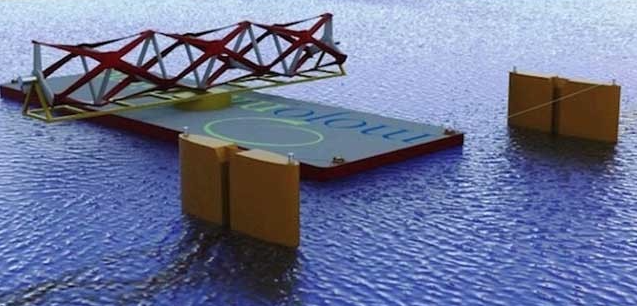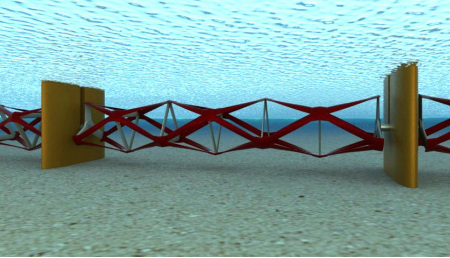Britse vinding: horizontale getijdenturbine
10 augustus 2015 – Onderzoekers van de universiteit van Oxford zijn een bedrijf begonnen met hun uitvinding: een horizontale getijdenturbine. De eerste grote (30MW) komt in een Brits kanaal.
Drie onderzoekers van de Universiteit van Oxford bedachten een afwijkend type getijdenturbine: een horizontaal ‘hek’ met bladen die in driehoeken zijn geplaatst. De turbine blijkt efficiënter en kan in meer wateren worden ingezet, ook in ondiep water.
De onderzoekers noemen hun vinding THAWT, de Transverse Horizontal Axis Water Turbine. Ze zijn een bedrijf begonnen (Kepler Energy) voor de productie van de THAWT’s.
De eerste grote toepassing komt in het Kanaal van Bristol.
Lengte van die turbine: 1 kilometer.
Vermogen: 30 MW.
Kosten: € 204 mln.
Gereed: 2021
Kepler Energy over de THAWT
‘(…) The Kepler Transverse Horizontal Axis Water Turbine (THAWT) is designed to be operated either in arrays or in stand-alone form. It is highly effective and efficient in terms of extracting the maximum power from given stretches of tidal or river current. Theoretical analysis and modelling, confirmed by testing, has shown outputs several times higher than those achievable by propeller type turbines placed in the same site. This advantage arises from (1) the greater rectangular swept area of a THAWT rotor compared with the depth limited circular swept areas of multiple propeller type rotors and (2) the fact that greater powers can be extracted from tidal flows by optimising the blockage ratio (swept area of turbine divided by flow area). Theoretical analysis has shown that, because of the free water surface in tidal flows, tidal turbines, unlike wind turbines, are not subject to the Betz power limit. The THAWT rotor design is better suited to this optimisation than conventional propeller type turbines.
The structure itself is novel, the blades themselves being configured so that the turbine rotor (called a triangulated stressed truss) needs no enveloping supporting structure (the truss structure feature is patented in key global markets). This leads to lower parasitic drag, and hence low power losses and simple, cheap construction with longer rotors across the flow. This is in contrast to all other transverse horizontal axis turbines on the market, which are limited in their power output by their lack of structural rigidity and consequent limited maximum size. (…)’
Uit een bericht van het Energy Harvesting Journal
‘(…) The simplicity of the patented truss design ensures the minimum of moving parts exposed to the tidal flow, whilst electrical equipment and controls are housed in dry columns. The rotor installation methodology requires no high cost specialist vessels, and can use much longer ‘weather widows’ than axial turbines operating in harsh weather and wave locations. Peter Dixon, Chairman of Kepler Energy said: “As our tidal technology can oper ate in lower velocity tidal waters, there is greater scope for its deployment in the UK and overseas. It means that we can achieve greater economies of scale as our projects are deployed. We can happily co-ex
ate in lower velocity tidal waters, there is greater scope for its deployment in the UK and overseas. It means that we can achieve greater economies of scale as our projects are deployed. We can happily co-ex
ist with tidal lagoons, and the power peaks will occur at different stages of the tide, meaning that the combined output into the Grid will be more easily manageable. In addition, our levelised costs of production will be in the range £100 to £130 per MWh for utility scale production, so costs will be cheaper than lagoons and in time we will be cheaper than offshore wind generation. Furthermore, investment risk is manageable since turbines are added incrementally to form the fence, with each one generating revenue as it is added.” (…)’
Bronnen
Energy Harvesting Journal, 10 augustus 2015: Bristol Channel beckons for tidal energy scheme
Website Kepler Energy
University of Oxford: Tidal Energy Research Group




